Brace for impact from the march of mega messengers!

This is a repost of our original article on ITProPortal
It was not long ago that Chris Messina wrote a centerpiece on 2016 being the year of conversational commerce. It was a welcome and accurate prediction needed by all of us. In the past year, we, at SendBird, have seen customers with transactional businesses pursuing services based on conversational interface. They range from on-demand (GO-JEK) and travel (Traveloka) to banking (KB Bank) and e-commerce (SSG International), among others. The conversation design differs from each industry and service. However, at the core of commerce, banking, and other business models is a conversation.
Luckily, we have been fortunate enough to receive heat from the trend in conversational transactions. Customers are mainly focused on two strategies: (1) incorporating conversational interfaces in-app (in-app customer service, in-app chat between multiple parties, and chatbots) and (2) customer service and chatbots layered on a messenger platform (WeChat, Line, FB, Kakao).
Most customers, especially enterprise customers, didn’t adopt one strategy or the other but instead adopted both because they represent different yet necessary marketing strategies for large enterprise customers.
- Customers chose to incorporate conversational interfaces because they wanted to customize the chat feature while maintaining continuity in the user experience. At the same time, this strategy strengthened brand identity and gave customers full ownership of all data. Researchers have argued that in-app messaging increases user retention. This meant that the larger the service, the more likely it was to internalize chat as a way to retain users. Further, customers who wanted a UX specific to their service, had no other option but to incorporate chat in-app, using a customizable Chat SDK.
- Customers chose messenger services under two circumstances: (1) when they lacked the development resources to develop in-app chat and (2) when they wanted to tap into the vast user base of messenger services.
A trend in the messenger market for service providers, A Cautionary Tale
I can’t agree more that embracing the march and pace of the conversational interface is crucial to taking advantage of the era of IP messaging. However, I have yet to hear a voice of caution, and frankly, that should concern us. As product owners, you’ll know if you don’t want (or can’t have) in-app messaging. So, I’ll leave that to you. Right now, however, I want to highlight a few points you should consider when thinking about choosing messenger based conversational services. Please keep in mind that my point of view is from the content and service providers, and not from the perspective of either a consumer or messenger platform.

How does your mobile engagement score stack up?
Based on various discussions with our customers, I believe now is still the time when messenger platforms can attract partners and customers with hefty incentives (or $0 cost) to try new services and experiences. This has been true for quite some time, but how much longer can it continue? The time will inevitably come when the freebies will stop. Well, fair is fair. It can mean, however, a few different things for service providers. The following will sketch a possible narrative. First, a transactional service will adopt a messenger, and it benefits both the messenger and the content/service provider. Next, multiple providers hop on the same messenger bandwagon to join the rising benefits. Inevitably, the messenger begins to charge for participation or transactions and creates a competitive market among the providers. Finally, product profitability decreases because costs increase. If that sounds familiar, you probably ran a service or developed a product in the early to mid-2010s.
While projecting too far into the future from past experience can be risky, history naturally provides valuable insights. In that spirit, I want to remind you of the changes many marketers and growth-hackers (and some companies) experienced during Facebook’s evolution. I too have bittersweet memories of the advent of Facebook pages for businesses and how it initially allowed me to generate fans, organic impressions, and app downloads.
The hidden costs of external channels: looking back to the rise of Facebook
In the past, acquiring likes on a Facebook page was such an important KPI for businesses that some even bought and sold Facebook pages. Some event built companies to facilitate such transactions. However, in a puff of smoke, organic impressions from the number of page likes (or fans) hit an upper-limit and began to dwindle. Many had no choice but to boost their content to keep up the reach. The graph below represents how diminishing organic returns was coupled with increasing paid returns Facebook. This is typically how monetization works for these platforms. The graph shows diminishing organic page reach vs. Facebook’s increasing valuation (ad revenue) between years 2015 and 2016. By the way, if you think this may be misleading because it should be looked alongside user growth as well, you are correct, read below.
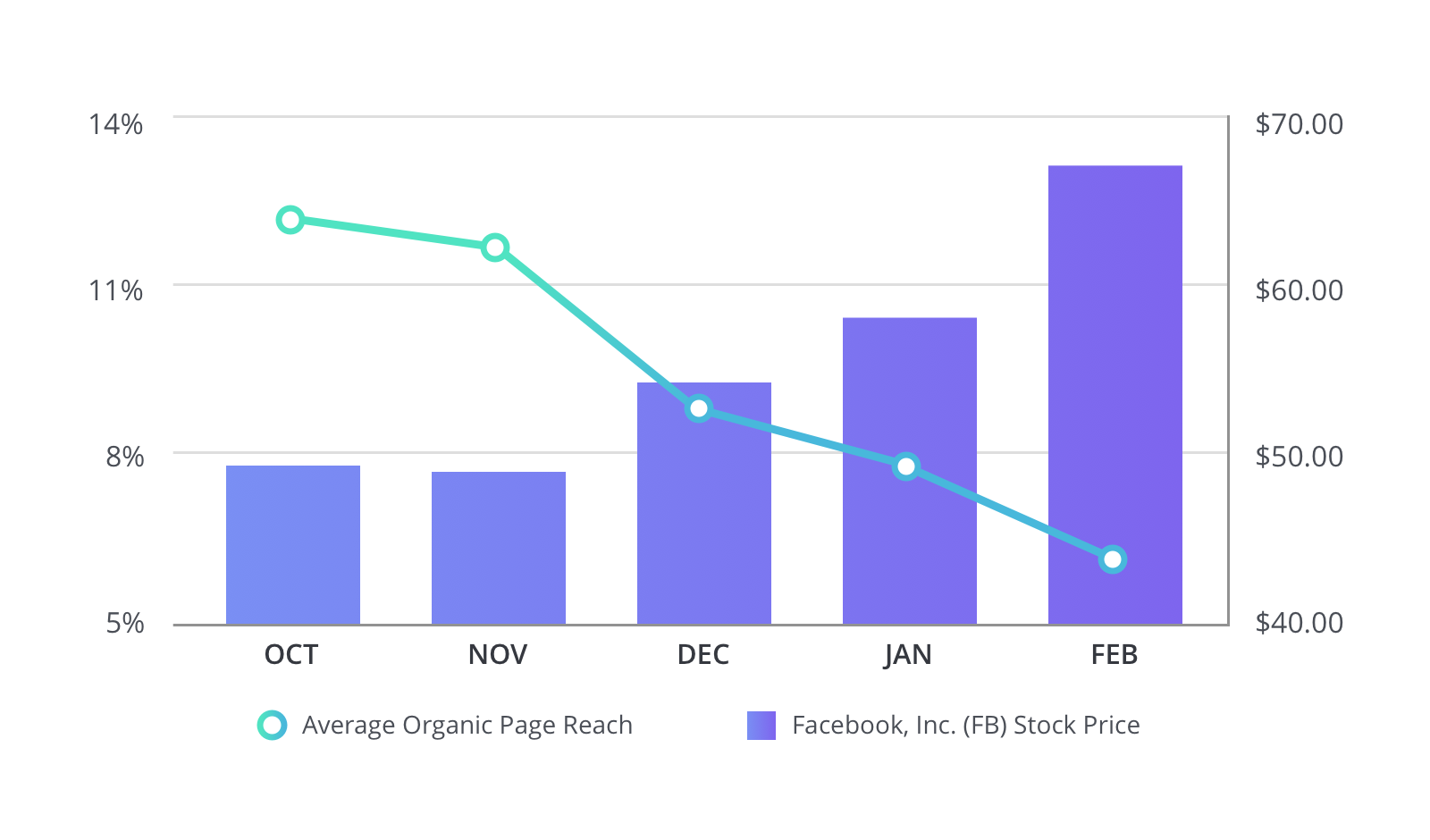
(*graph source)
Parallel to the diminishing organic reach of content published on Facebook, app installs advertisement costs on Facebook showed the same trend. You might’ve often heard from sales that CPI usually decreases when a campaign runs at a higher volume (larger budget). It’s actually difficult to determine the validity of this statement.
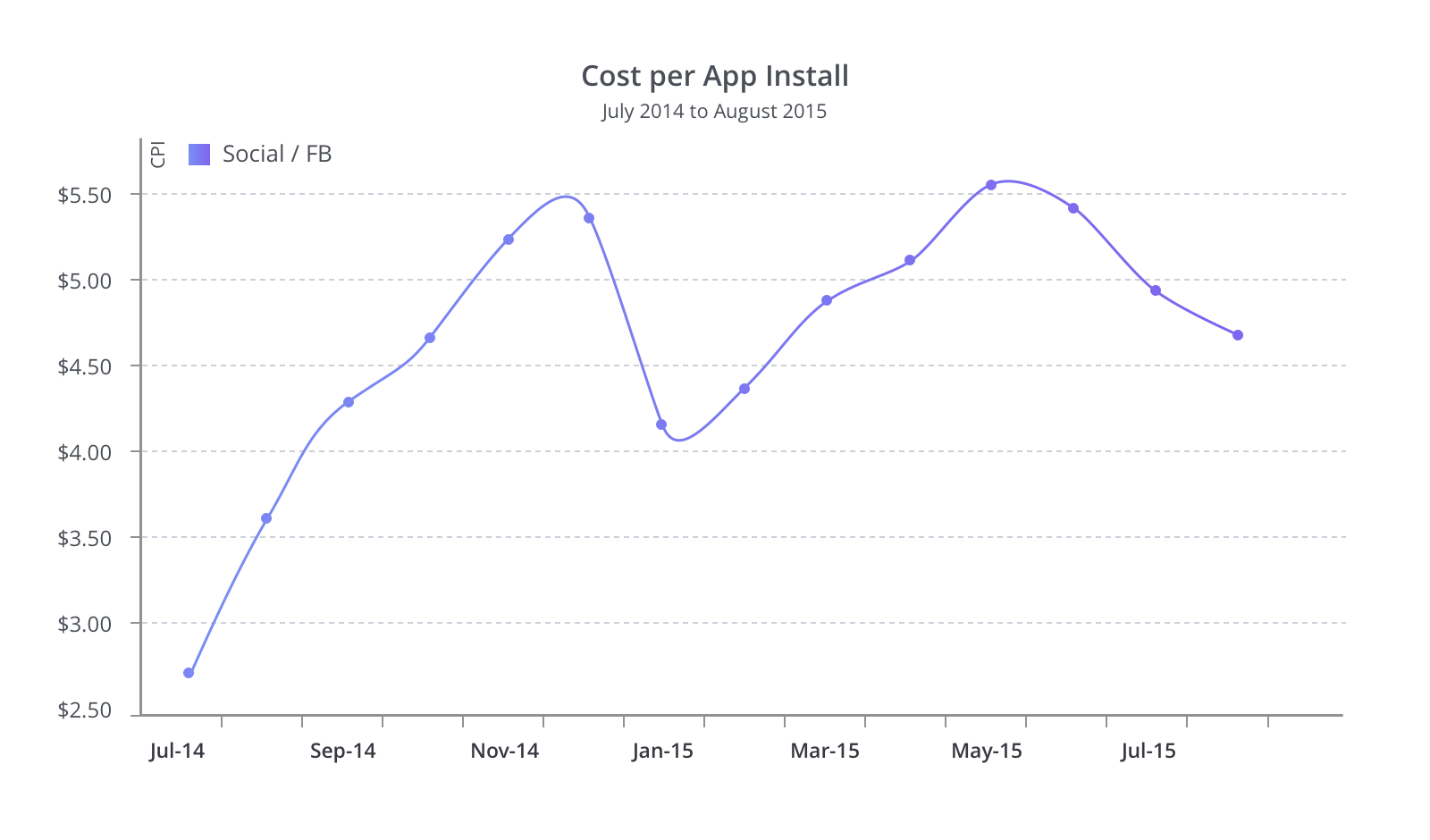
What surprised me the most was that while the Average Revenue Per User (ARPU) increased 224% from US$6.03 in December 2013 to US$13.54 in December 2015, Facebook’s MAU increased 13% from 193 million to 219 million (Facebook ’15 annual report). Despite the asymptotic growth of its users, Facebook managed to nearly double the revenue generated by each user. In those days, 95% of Facebook’s revenue was from advertising, most likely supplied by the companies that participated in providing content and developing a community on Facebook. And, yes, to be fair, the rising costs may have been avoided by transferring it to the consumer.
Ultimately what I hope I can show you is that conversational services based on messenger platforms may seem attractive in the short term, but in the long term that may very well not be the case. So, by brining your attention to the hidden long-term cost, I want to caution you about the risks of becoming dependent on messenger platforms. Platform based services have their strengths and benefits, of course, and it will serve you well if you are prepared for the many phases during the short-, mid-, and long-term growth strategy. But you must be cautious of the scenarios in which the steep rise in costs overshadows the immediate benefits. To be sure, these cost curves will not look like the CPI curve. Dependence on external channels will ultimately require heavier costs than expected. Continuing to benchmark your KPIs around external channels might result in a future where cost increases quickly gobble up the sweet returns in the past.
It may seem ironic to advocate for greater autonomy by internalizing the conversational experience, especially at a time when all services (and even hardware) are tightly interconnected. For online services, it is nearly impossible to detach oneself from external channels like social networks. However, it has its place because it generates new users by increasing the awareness amongst potential users through various marketing and advertising activities. It would be folly, however, to run an entire business on it, though of course there are exceptions. Unfortunately for conversational interfaces, they can’t be run like you would a regular social networking service.
The dream of an all-encompassing UI: the conversational interface
Amongst industry participants, the conversational interface is often called “zero interface” or sometimes “zero UI” because it can digest an infinite number of user experiences in chat. If you think about how different the user interfaces of Uber, Yelp, and Venmo are from each other, it is very difficult to imagine a service that can unify them under an umbrella interface. However, it is standard for the conversational interface to provide all those services on top of a single user interface. The KITT.AI video shows a good visual representation of how that can work. This then begs the question of what the difference might be between a conversational service provided by a messenger and a service provider’s internalized conversational service.
Or worse, why would users come to service A, B, and C if they are all equally available on a messenger and the experience is identical? To understand the frustration this might cause, you must believe somewhat that users will prefer to stick to a conversational interface that they are familiar with and that they’ll avoid adjusting to a new user interface. Ideally, it may mean that service providers could re-allocate the time and effort invested in a separate UI by focusing instead on their core product/content/service. But how easy is that in reality? If by any chance, you deem a conversational interface as critical to your service, it may not be an exaggeration to say that there could be significant cannibalization of your own services if you were to provide the same experience internally and through messengers.
The good old days of open market services
I want to present you a story that is a good analogy for why external channels/platforms are so attractive. One of our retail brand customers told us a story of the time open markets were booming in the early 2000s. When open market services were gaining traction, retailers with their own websites had to decide if it would be a good idea to partner with open markets. They, too, feared a potential cannibalization. Surprisingly, there wasn’t any. In fact, open markets only helped increase revenue by enabling brands to tap into new customers who preferred to shop online.
However, our customer also mentioned how the current situation with the conversational interface (whether internal or messenger based) differed from this success on two large fronts. First, open market customers were very different from retail brand customers. Therefore, extra attention—not cannibalization—was gained. This naturally translated to an increase in revenue. Second, no single open marketplace player dominated the market nor possessed an extreme share of the addressable population as messenger platforms do. Even to this day, a decade or more past the growth of open market services, we still have a variety of open market places in each region and country.
The success of retail brands in the open market doesn’t seem to stand for messengers. Today, users may send chats on messengers instead of texts or calls. There is a high probability that an e-commerce user is also on messenger, so there isn’t access to as many new users as in the past. Messengers also have almost complete dominance in their respective regions. In other words, providing the same conversational experience on a messenger platform and one’s service can create future head-to-head competition between the two. What kind of incentive and how much of it would users need to use both services if they can go to a messenger for an identical and possibly broader experience?
The power of mega messengers
Kakao’s launch of its grocery delivery service in April is a good example. Besides what you would expect from a grocery delivery app, it also provides additional messenger features that allow you to share a shopping cart with others on your contact list. Out of curiosity, I turned on Instacart to compare the two services. Left is Kakao’s grocery delivery service and the right is Instacart, though in different languages. To me at least they seem remarkably similar.
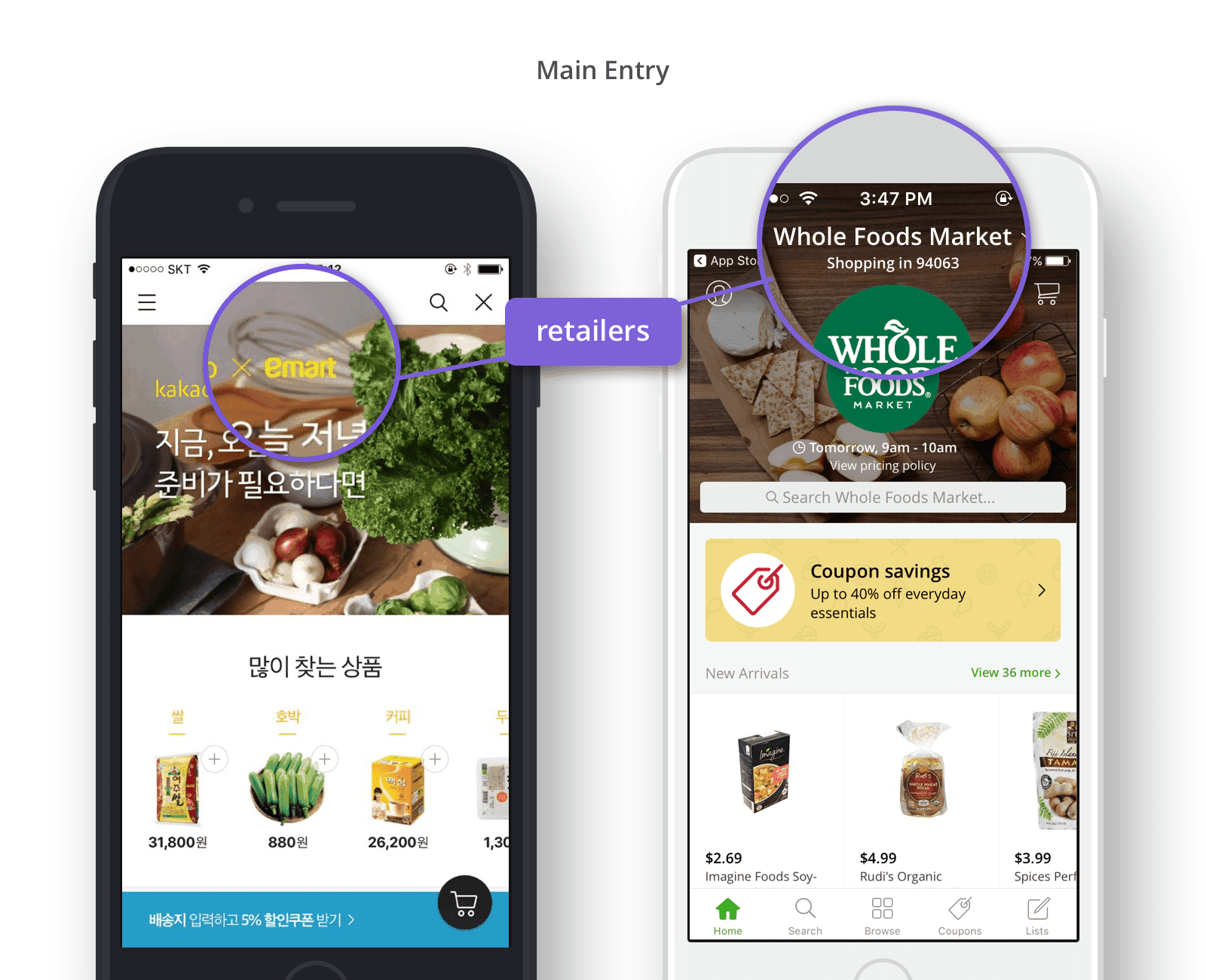
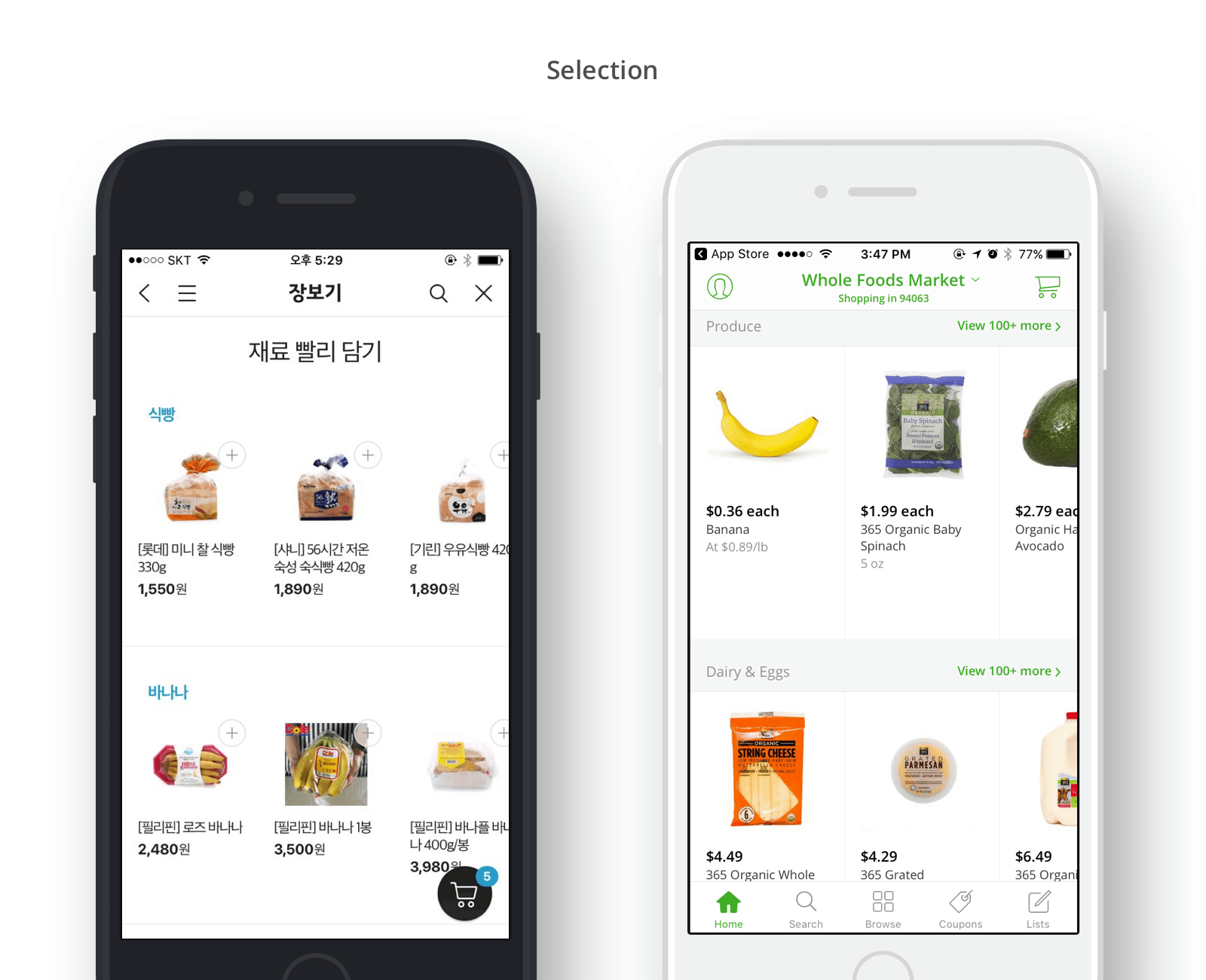
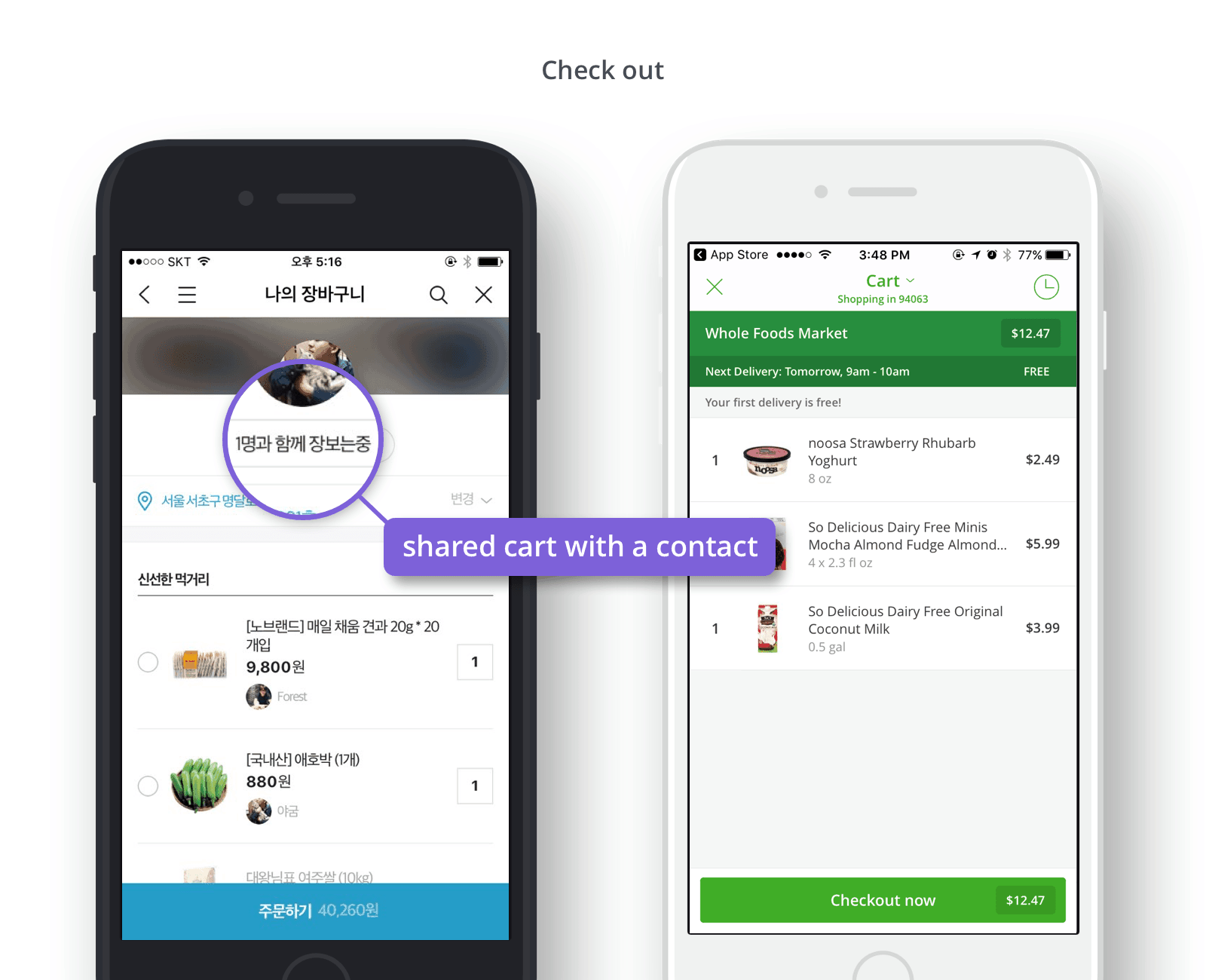
It is only natural that messengers may grow into service areas previously dominated by companies that sometimes rely heavily on communication and marketing through its core messenger service. Earlier this year, Kakao launched a food delivery service on its messenger, and it now boasts 2 million weekly users. Can you think of any delivery services around the globe that grew to 2 million weekly users within a few months? This is possible only because Kakao is the dominant messenger platform in Korea. So, how should you embrace the rise of conversational interfaces in a way that is advantageous to your service?
Embracing the power of conversational interfaces, what’s your plan?
The good news is that all this trouble we’re going through to provide a cautious opinion is because conversational interface based services can be that much more powerful, no matter if they are internal or external. In the foreseeable future, the conversational interface will replace many user interfaces we currently interact with. Especially considering the attention economy, this trend is almost inevitable in the perspective of messenger apps. For services that rely on online interactions with users to generate cash flow, conversational services are already becoming essential because it’s already a core part of consumer’s lives. Still, you must quickly discern the cost and benefit of messenger based conversational services so as not to lose all value of the user interface. I sincerely hope that you will successfully embrace the era of conversational interface to reach, if not surpass, all your short to long-term business goals, especially by finding the right balance between internalization and external channels.










